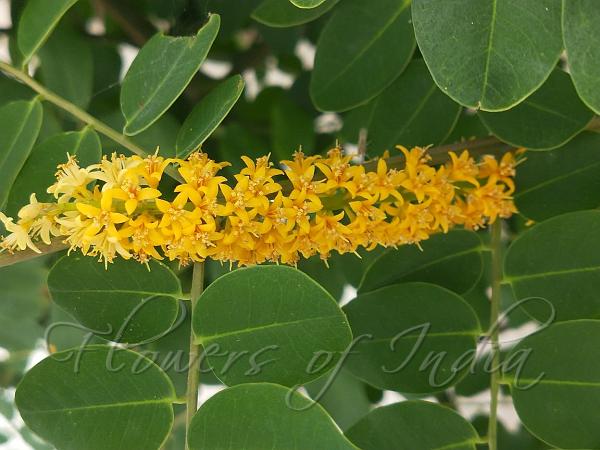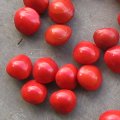|
| Red Bead Tree |
|

|

|
|
|
|
Photo: |
Botanical name: Adenanthera pavonina Family: Mimosaceae (Touch-me-not family)
Synonyms: Adenanthera gersenii, Adenanthera polita, Corallaria parvifolia
Synonyms: Adenanthera gersenii, Adenanthera polita, Corallaria parvifolia
Red Bead Tree is a timber tree. This plant is found in the wild in India.
Leaves are compound bipinnate, green when young, turning yellow when old. The small, yellowish flower grows in dense drooping rat-tail flower heads,
almost like cat-tail flower-heads. Fruits are curved, hanging, green pods that turn brown, coil up and split open as they ripen to reveal small bright red seeds.These attractive seeds have been used as beads in
jewellery, leis and rosaries. They were also used in ancient India for
weighing gold. The seeds are curiously similar in weight. Four seeds make
up about one gramme. Children love the hard red seeds and few can resist
collecting the brightly coloured seeds usually littered under the tree.
The young leaves can be cooked and eaten. the wood is extremely hard and
used in boat-building and making furniture.
Medicinal uses: A red powder made from the wood is also used as
an antiseptic paste. In Ancient Indian medicine, the ground seeds are used
to treat boils and inflammations. A decoction of the leaves is used to
treat gout and rheumatism. The bark was used to wash hair.
A red powder made from the wood is also used as
an antiseptic paste. In Ancient Indian medicine, the ground seeds are used
to treat boils and inflammations. A decoction of the leaves is used to
treat gout and rheumatism. The bark was used to wash hair.
 Photo: Radhika Vatsan |
Medicinal uses:
 A red powder made from the wood is also used as
an antiseptic paste. In Ancient Indian medicine, the ground seeds are used
to treat boils and inflammations. A decoction of the leaves is used to
treat gout and rheumatism. The bark was used to wash hair.
A red powder made from the wood is also used as
an antiseptic paste. In Ancient Indian medicine, the ground seeds are used
to treat boils and inflammations. A decoction of the leaves is used to
treat gout and rheumatism. The bark was used to wash hair. | Identification credit: Prashant More | Photographed in Tripura & Mumbai. |
• Is this flower misidentified? If yes,